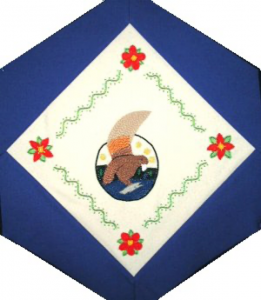Chipewyan

The Block
An embroidered eagle with a fish in its talons soars above a scenic backdrop in the Chipewyan block, obtained through Rita Catholic. Chipewyan spirituality tells how the eagle carries the prayers of the people to the Great Spirit. Eagle feathers are given to honour unselfish acts of compassion and generosity. Each corner features a stitched flower, with flattened porcupine quill petals, linked by flowing curved lines accented with delicate beadwork, creating a frame for the piece.
Cultural Profile
The Chipewyan (Denesuline) are an Athapaskan-speaking, Dene people. Their lands and influence once extended east of Great Slave Lake and south into what has become northern Saskatchewan and northeastern Alberta. The name, Chipewyan is said to have come from the Cree word meaning “pointed skins,” which was a reference to the style of caribou-skin, sleeved shirt they wore with shirt-tails cut to a point front and back.
They were great caribou hunters, following the herds into the northern areas in summer. In warmer weather they relied on canoes for travel, but were adept at winter travel, with snowshoes and toboggans. A major food source, the caribou’s skin was also used to cover their homes, cone-shaped, easily transportable tepees. Their distinctive Na hlcheth bags––rectangular, satchel-like, laced sacs that held dried meat and berries, or valuables––were made from the skin of the caribou forelegs.
The other main source of protein was fish, which Chipewyans would catch using nets made from hide. Many ceremonies would be performed before a fishing excursion, to ensure a bountiful catch. They have a great respect for animals and attributed special powers to wolverines and wolves. In Chipewyan mythology, the Wolf is a teacher, providing instruction to the people on how to survive in the harsh sub-Arctic climate. The wolverine embodies perseverance and a healthy self-esteem.
Sponsor: Joyce and Jack McGaughey
